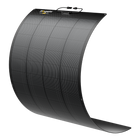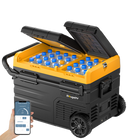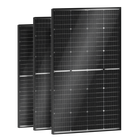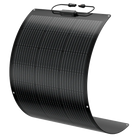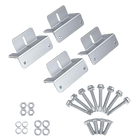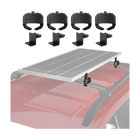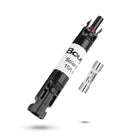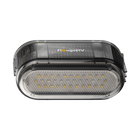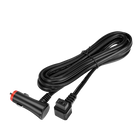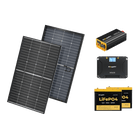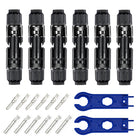CIGS Solar Panels for Commercial Applications

Solar installations in the United States are growing tremendously in the last decade. This growth is for several factors like the reduction of solar system costs, federal incentives, environmental concerns, and growing demand for clean renewable energy.
Look at the chart below. The research data by the Solar Energy Industry Association shows that more than 130,900 megawatts (MW) of solar capacity were installed in the US by 1st half of 2022 which is enough to power 23 million homes. The installed capacity was less than 10,000 MW in 2012. The residential and commercial segments contributed to a significant part of this incredible growth story.
- Unfolding a New Era
- CIGS Solar Panels In Commercial Applications
- CIGS Solar Panels For Agriculture Applications
- FAQs

The Inflation Reduction Act of 2023 is expected to bring unprecedented growth in solar installations in the next five years. $369 billion is planned to invest in energy security and climate change programs over the next ten years under this Act.
Unfolding A New Era
The growth of solar so far is mostly based on crystalline solar panels mostly polycrystalline and monocrystalline solar panels. But another technology is coming up and grabbing the market share silently and that is called CIGS solar panels.
CIGS means Copper Indium Gallium Selenide and is a thin film technology. It has a number of advantages over rigid glass-topped crystalline solar panels, particularly for commercial applications that are going to be articulated here.
CIGS Solar Panels In Commercial Applications
Flexible CIGS solar panels are the latest technological wonder. These cells are very thin, lightweight, flexible, and generate more electricity than the crystalline variety.
Rooftop solutions and Solar shingle tiles
As the CIGS solar panels are 10 times lighter than conventional crystalline solar panels and flexible, they can go as a layer on the top of roof tiles and shingles. The crystalline solar panels need a metal racking system to fix them on the top of tiles or shingles and look clunky. As the rigid crystalline solar panels are heavy, they need a heavier racking system. Another danger of putting rigid panels on the roof is it increases the risk to the roof of increased wind load.
Therefore, CIGS panels are a much safer option than crystalline solar panels and aesthetically look good. The flexible CIGS 200W solar panels from BougeRV are very easy to fix on the roof. Just peel the adhesive tape and fix it on the roof surface. And it is ready to generate electricity.
Commercial or utility-scale installations
CIGS solar panels are very attractive for large rooftops like industrial shade, commercial building roofs, car parking shades, or large utility-scale solar power as it produces more electricity in a day. CIGS solar panels are more sensitive to light as they can absorb more wavelengths from the light spectrum.
CIGS solar panels, though it is slightly costlier than crystalline solar panels, can tape the light early in the morning hours and late in the afternoon compared to crystalline solar panels. That gives an extra edge to the CIGS panels to produce more electricity on any day of the year.
Another factor, that reduces the capital cost is the lighter or no panel mounting structure to install the solar panels in the case of CIGS. That reduces heavy metal structure in large utility-scale solar power installations. Moreover, that reduces the installation cost.
Therefore, CIGS solar panels are more commercially viable for a large commercial installation as they will give a better capacity utilization factor (CUF) and internal rate of return (IRR).
Building Integrated Photovoltaics (BIPV)
Another interesting application and is an architect’s delight of flexible CIGS solar panels is in Building Integrated PV (BIPV). In BIPV, solar panels are installed with the building envelop itself. That means, solar panels are installed as windows, glass facades, roofs of the building and solar panels become part of the building material producing electricity.
There are several advantages of BIPV. First, the CISG panels replaces the window or façade glasses of the building. That actually reduces the cost on the part of the building material. Savings from that can be used to procure CIGS solar panels. Second, CIGS solar panels on the facades of a large commercial building reduces the heating or air conditioning load of the building.
Reason behind this is very simple. As the CIGS panels are semitransparent, it allows light to come to the inside of the building but not fully. That reduces the heat gain or heat loss of the building during daytime.
Third, CIGS panels as BIPV looks pretty good aesthetically. That is why architects love it and goes well with modern look of any commercial building like large office building, shopping malls, convention centers, or anything one can imagine. Fourth, and most important it produces free electricity that can make any commercial building get a green building certificate with net zero electricity consumption.

CIGS Solar Panels For Agriculture Applications
As the CIGS solar panels are very lightweight and flexible, they can go well with greenhouses very well. CIGS solar panels from BougeRV are used by many farmers in North America and happy with the performance and look of the CIGS panels.
200W Flexible CIGS panels from BougeRV can be easily fixed on the curvy top greenhouses in farmland. CIGS panels do not block the light fully. So, the plants inside the greenhouse got the required amount of light. As the CIGS panels are ten times lighter than the rigid and heavy crystalline panels, they do not put a heavy load on the greenhouse and are safe structurally.

CIGS panels with agrivoltaics
Agrivoltaics is the use of the same land to do agriculture and generate electricity by solar photovoltaic (PV) systems. This is a pressing need and offers tons of benefits to its stakeholders and the environment. Land area is limited, and large ground-mounted solar systems need a huge area of land.
Demand for solar energy is increasing. But finding suitable land to develop commercially viable solar projects becomes increasingly difficult. The conflict between using land to decarbonize the energy sector and food security is imminent. As we need more and more solar energy, lands best suited for a solar park are typically used to grow food.
Flexible, lightweight CIGS solar panels from the BougeRV can be boon to farmers to put solar panels in the agricultural land and produce electricity. That can be another income stream for the farmer using the same farmland – agriculture production and selling power.

Be a part of the solar growth story
Therefore, don’t be left out alone. Come and join the growing solar community at this opportune moment. Take the advantage of government incentives, tax benefits, and use cheaper cleaner solar energy by adding solar to your residential or industrial roofs, grounds, and greenhouses.
Even as agrivoltaics for your entire farmland. BougeRV is a pioneer in promoting flexible CIGS panels and can help you navigate this exciting journey by hand-holding your selection of the right panels, design, and installation of solar systems. Just leave your details here and a representative from BougeRV will contact you to understand your need and find the best solution for you.
FAQs
How CIGS solar panel can produce more electricity?
Compared to crystalline solar panels, CIGS solar panels can produce 10 to 15% more electricity in a year. CIGS cell cells are light sensitive and can capture more light in the early morning hours and late afternoon which is on the longer wavelength side of the light spectrum. Since CIGS solar panels can capture lights for more hours in the daytime, they can produce more energy.
How can CIGS panels reduce the capital cost of a commercial system?
CIGS solar panels are very lightweight. They do not need a heavy metal racking system or panel mounting structure. That saves dollars and the capital cost of the entire solar system.





